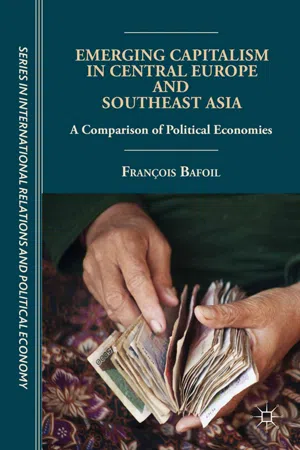![]()
N O T E S
Introduction
1. Peter A. Hall and David Soskice (eds), Varieties of Capitalism: The Institutional Foundations of Comparative Advantage, Oxford: Oxford University Press, 2001.
1 What Is an “Underdeveloped” State in Historical Terms?
1. In using the term Eastern Europe, I adopt a political perspective that isolates the ten new EU member-states that, as will be seen later, refer to the North as Baltic Europe, to the Center as Eastern Europe, and to the South as Balkan Europe. The historical trajectories of these three groups, before and during communism, and the institutional arrangements built after 1990 reveal significant differences. They also differ from Western Europe, a term that typically encompasses the older EU member-states (EU15)—despite the deep distinctions that also divide them and that do not concern us here. For these reasons, I avoid geographers’ distinctions between “Middle Europe,” “Central Europe,” and “East Central Europe,” which emphasize the territorial aspects and connections, networks, and other links, while placing less emphasis on institutional arrangements. For more on this subject, see Gilles Lepesant, 2011, Géographie économique de l’Europe centrale: Recomposition et européanisation des territoires, Paris: Les Presses de Sciences Po.
2. Nicholas Tarling, in the introduction to the second volume of the major work on the history of Southeast Asia, stresses that “Southeast Asia is still a useful category, though we should always be on our guard lest we are tempted to over-emphasize either its cohesion or its diversity.” Nicholas Tarling (ed.), 1999, The Cambridge History of Southeast Asia: Volume Two, Part Two, From World War II to the Present, Cambridge: Cambridge University Press, p. xii. See also the discussion of borders in Paul H. Kratoska, Remco Raben and Henk Schulte Nordholt (eds.), 2005, Locating Southeast Asia: Geographies of Knowledge and Politics of Space, Southeast Asia Series, no. 111, Singapore: NUS Press; as well as the major work of Thongchai Winichakul, Siam Mapped: A History of the Geo-Body of a Nation, Honolulu: University of Hawai’i Press, 1994; and Amitav Acharya, 2010, “Asia Is Not One,” The Journal of Asian Studies, vol. 69, no. 4, pp. 1001–13.
3. As regards the “state back in” approach, see Peter B. Evans, Dietrich Rueschemeyer and Theda Skocpol (eds), 1985, Bringing the State Back In, Cambridge: Cambridge University Press.
4. Søren Ivarsson, 2008, Creating Laos: The Making of a Lao Space between Indochina and Siam, 1860–1945, Monograph Series, no. 112, Copenhagen: NIAS Press.
5. The Kingdom of Siam transformed itself into Thailand in 1938; see chapter five.
6. Chris Baker and Pasuk Phongpaichit, 2006, A History of Thailand, Cambridge: Cambridge University Press; Rachel V. Harrison and Peter A. Jackson (eds.), 2010, The Ambiguous Allure of the West: Traces of the Colonial in Thailand, Hong Kong: Hong Kong University Press.
7. Norman G. Owen, “Economic and Social Change,” in Nicholas Tarling (ed.), 1999, The Cambridge History of Southeast Asia: Volume Two, Part Two, From World War II to the Present, Cambridge: Cambridge University Press, Chapter 3, pp. 145–6.
8. I focus more on this first group in the study, but it does not rule out extending our reflection to other countries, including Thailand or Singapore, for example.
9. Regarding the Doi Moi reforms, see chapter five.
10. David P. Chandler, 1983, A History of Cambodia, Boulder, CO: Westview Press.
11. Caroline Hugues and Kheang Un (eds.), 2011, Cambodia’s Economic Transformation, Copenhagen: NIAS.
12. Robert H. Taylor, The State in Myanmar, Singapore: NUS Press, 2009. See also ASEAN 2030, Towards a Borderless Economic Community, Asian Development Bank Institute 2012, specifically the section on Myanmar by Jean-Pierre Verbiest and Tin Htoo Naing, available at www.adbi.org/files/2012.03.30.proj.material.asean.2030.highlights.pdf (Accessed on November 25, 2013).
13. Amitav Acharya, 2009, Constructing a Security Community in Southeast Asia: ASEAN and the Problem of Regional Order, Politics in Asia Series, Abingdon: Routledge, 2nd ed. First edition available online at http://fmc90.files.wordpress.com/2010/05/constructing-a-security-in-asean.pdf (Accessed on November 25, 2013).
14. According to a UNHabitat report, population forecasts for 2025 in some of the major asian cities are as follow (thousands) : Ho ChiMinh City: 8,149; Yangon: 5,869; Hanoi: 6,754; Singapore: 5,104; Bandung: 3,370; Bangkok: 8,332; Manila: 14,808. Report available online at www.unhabitat.org.jo/en/inp/Upload/1052216_Data%20tables.pdf (Accessed on March 3, 2014).
15. Natalia Aleksiun et al., 2004, Histoire de l’Europe du Centre-Est, Paris: PUF.
16. Slovakia formed the heart of the former Moravia, which over the centuries was subjected to Ottoman and Hungarian forces. It was never recognized as a country, except by Hitler between 1939 and 1944, when it was under the authority of an archbishop, Monsignor Tiso, who was allied with the Nazis.
17. Occupied by the Ottomans from 1540 to 1699.
18. In view of recent developments, it seems appropriate to add Slovenia, a region of Yugoslavia prior to 1988 and previously a part of Italy.
19. Bulgaria was occupied from the late fourteenth century to the late nineteenth century. The Romanian provinces of Moldavia and Wallachia were occupied by the Ottomans for the same period. The province of Transylvania was occupied in the fifteenth century.
20. During the short period of June 1953.
21. For a recent analysis of the 1956 revolution, see “La révolution hongroise de 1976: Nouvelles approches,” Communisme, special issue, no. 88–89, 2006–2007.
22. Gordon Harold Skilling, 1976, Czechoslovakia’s Interrupted Revolution, Princeton, NJ: Princeton University Press.
23. François Bafoil (ed.), 2007, La Pologne, Paris: Fayard.
24. Jan Winiecki, 2004, “Determinants of Catching Up or Failing Behind: Interaction of Formal and Informal Institutions,” Post-Com...
